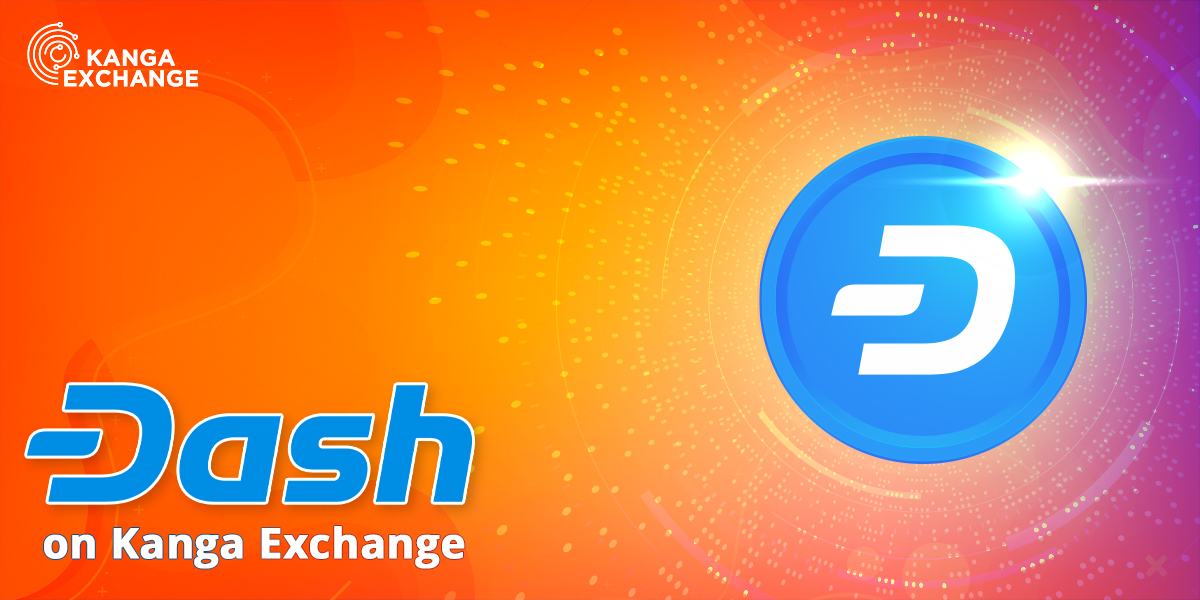Dash on Kanga Exchange

Written by
Kanga
Published on
Dash – a new blockchain available on Kanga from Wednesday, 27 July!
Dash is one of the oldest blockchain networks, with its first block mined on 19 January 2014. It is a Litecoin fork, which itself forked from the Bitcoin protocol. Hence, in many respects Dash resembles the ‘digital coin’, the name often used to refer to Bitcoin. According to Evan Duffield, the main reason for creating Dash was the insufficient bandwidth of the Bitcoin blockchain and the lack of privacy thereof.
One of the main differences between Dash and Bitcoin is the speed with which the blocks are mined. While Bitcoin blocks are mined every 10 minutes on average, the Dash blockchain allows for the blocks to be mined every 2,5 minutes. To achieve this speed Dash uses the so-called two-tier network. On the one hand, we have the cryptographic method known as Proof of Work (so the miners who compete for creating blocks by adding and securing transactions). On the other hand, it uses the so-called MasterNode (who helps the Miners by ordering and verifying transactions). Each MasterNode must stack 1000 Dash coins, which serve as the security for their operation (no frauds, low quality etc.). At the beginning of 2022 the blockchain consisted of 4,933 active nodes (historically, the maximum number of nodes went over 5 thousand), which along with the miners’ activity guarantees the decentralized nature of the network. Moreover, since December 2017, when Evan Duffield resigned from his post, Dash has been fully managed and developed by a decentralized autonomous organization called Dash DAO.
Dash is protected by the X11 algorithm, which was developed by the blockchain creator, and which is based on eleven most secure cryptographic techniques known in 2014. Thanks to that, even finding vulnerability in a few of the algorithms sill does not allow for the blockchain security keys to be cracked. 10,831,251 Dash coins have been mined up to this moment. Each year the number of mined coins decreases by 7%, and the full number of the coins – in the total amount of 18,900,000 – will have been mined by 2045. 45% of the coins go to the miners, another 45% to the MasterNodes and the remaining 10% is spent on developing the blockchain.
Currently Dash ranks 92nd in the cryptocurrency ranking, although it reached the 12th position in 2018.
Many of you have certainly heard that Dash can be used to pay not only while shopping online, but also in local stationary shops. For example, Venezuela is characterized by one of the widest scope of adopting cryptocurrencies in the world (according to the latest survey as many as 2,9 million people already own cryptocurrencies there). It is also accepted by many small shops, as well as larger companies, such as Travala or NordVPN ➡️ Where to spend Dash
Where does such a wide interest in this cryptocurrency and the option of quick payments come from since we have mentioned above that the blocks are closed every 2,5 minutes? It is all thanks to a number of unique functions that have been implemented in the blockchain.
These functions are as follows:
InstantSend – thanks to this function MasterNodes instantly block an adequate amount of funds in the sender’s wallet, make the information public throughout the network and guarantee that the transaction is included by the miners in the next blocks. Thanks to that, the funds will be sent from one blockchain user to the other within 1-2 seconds
Chainlock – this function provides certainty of the transaction when payments are to be received. The technology allows the user to receive payments instantly and without any risk of ‘a chain reorganization event’. Thanks to that, we do not need to wait for a confirmation in the next, say, 6 or 12 blocks, as is the case with the Bitcoin or Ethereum blockchains.
PrivateSend – allows for sending funds anonymously by concealing the sender and recipient. The function shaffles a number of different transactions, which makes it more difficult to track them. Due to that fact, Dash is considered to be an alternative to Monero (a private cryptocurrency). We must, however, remember that this function is optional and the user must enable it intentionally.
These functions alongside low transfer costs (between $0,2 and $0,3) contributed to the huge popularity of the blockchain.
If you wish to send your coins outside the exchange, we suggest using one of the wallets recommended on the official DASH organization website
Trade ➡️ DASH – USDT
Start – The 27th of July 2022, 5:00 PM UTC
Withdrawals – The 3rd of August 2022, 11:00 AM UTC